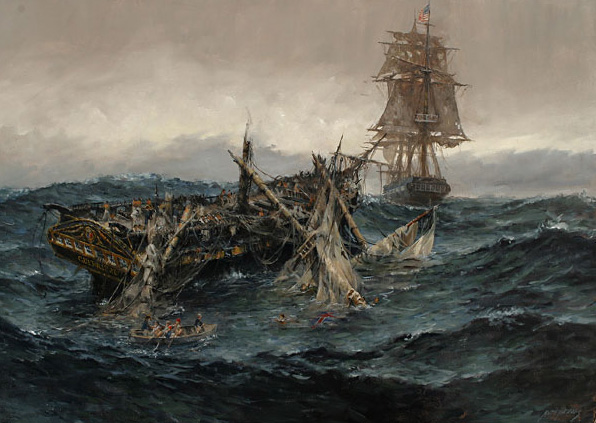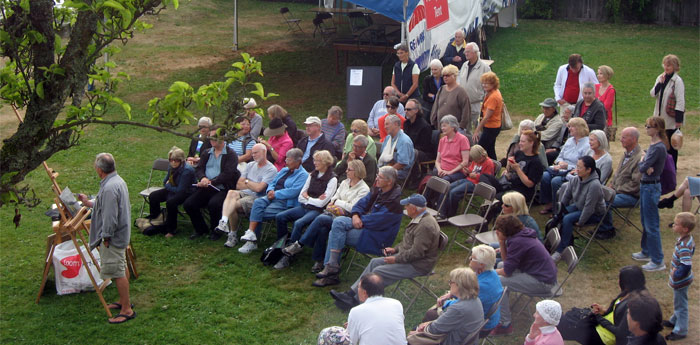

USS Constitution Vs. HMS Guerriere oil painting by Andy Thomas, USA |
Archived Comments
Enjoy the past comments below for In praise of inexpensive materials…
Dear Robert, I always tell artists that a good painting starts with quality materials. I would rather see two good pieces then 20 pieces of half-baked work. Student quality paint is good for Elementary school students! I remember meeting with an upscale gallery once who actually took time to view my paintings. They said “what is the antiquitous qualities of your work?” I responded with “that what?” The point the gallery was making is that they want to make sure the painting, once sold, is not returned five years later all faded or cracking. I am also a Golden Paint artist. I, however, am a Golden Purist and would NEVER mix anything but Golden Paint with Golden paint. But i have to disagree Robert as the most important thing in paint is not the medium, it is the pigment. The pigment delivers the colour and at the end of the day, nothing is more important to a painting than colour. “…I want my paintings to be exquisite, therefore the chosen materials are the very best…” I just made up that quote! John Ferrie
I’m getting in before the other South Africans on this mailing list! In South Africa, it has long been a common sight to see small boys playing with toy cars they had fashioned out of galvanised wire. Considering the youth (usually between eight and 12 years old) of the young craftsmen, one has to admire their ability. In recent years wire work has become a sophisticated art form, with many adult artists taking it to breathtaking levels. I have taken the liberty of inserting a few website links, though if you were to google African wire art you would find far more. Granted, many items are created to sell to tourists, and could be seen as a bit kitsch, but look closely – the skill is incredible. The well-known African art-form of intricate beading is incorporated in many pieces, as are cleverly-cut and integrated pieces of metal, from soft-drink cans! Ladies, note also the cute bracelets, made of beaded safety pins. ;-) http://www.africa-adventure.org/s/streetwiresarts/index.html http://news.bbc.co.uk/1/shared/spl/hi/picture_gallery/07/africa_wire_art_exhibition_in_south_africa/html/1.stm http://www.sbmastore.net/south-african-safety-pin-bracelet-pr-16270.html http://www.africasmiles.co.za/wirework.htm
I am a tempera painter and former ceramist, and have found that the inexpensive metal oxides and Mason Stains I bought years ago from my ceramic supplier serve just as well as the pigments sold by art suppliers. I can’t get absolutely everything I need from the ceramic world, but given the abundance of choices and relatively low prices, I always look there first.
A fine artist with inexpensive materials will produce a superior piece while a less able one with the most expensive of materials will still produce mediocre work. At some point ability replaces materials cost. Beyond saturation permanency is the dividing line. Maybe Im wrong, but I dont see curators agonizing over restoring my paintings four hundred years from now. Thats their challenge. Manipulating wire is similar to an art school exercise of putting pen or pencil to paper and drawing without lifting the tool from the surface. It demands economy of movement and produces an abbreviated drawing that can be more appealing than a detailed composition. One of the most amazing sculptures Ive ever seen was an elaborate Nativity scene formed entirely in chicken wire. The wire was fabricated into three dimensional figures as the wire was curved, depressed, puckered, folded, and pulled, giving each piece remarkable detail. One could see eyes, lips, nose, and mouth, even hands. The same attention was given to forming a camel, sheep, and donkey. The amateur (not!) sculptor spray painted eight life sized pieces with white spray paint and the whole scene was lighted at night. Ive never forgotten the skill exhibited by that sculptor and it inspired me to one day try my hand at it.
Franz Kline often used marginal or inappropriate materials. Perhaps he felt that what he was doing deserved the materials he used to do it (I don’t know). In any case, many of his fine abstractions are falling apart, having been crafted of newsprint and house paint. (It must be disturbing to have paid a large sum for one of those works, only to have it decomposes.) The lesson, I suppose, is that there are limits to the effective substitution of “more humble” materials, when others are available. It would be nice to believe that such substitutions only occur when it’s germane to the nature of either the other materials, or the work itself.
If we begin to utilize materials of lesser value (read: functionality) can we really know what the ultimate impact will be on our work? It might take scores of years for the cheap material to begin to degrade, and we might never understand it to be inevitable, happily cobbling together materials into compounds that are doomed. It’s like playing at dice.
I love gesso and acrylic matte and gloss mediums! You can use them to isolate the surface of any flat, durable materiel and paint on it. I’m not getting into whether it’s OK to paint oils over acrylic mediums or paints, but it’s worked fine for me for decades with no sign of deterioration. I use mat cut-outs, gessoed on both sides to reduce warping, for inexpensive paint panels — and you can make them any size you please and save a trip to the art store. You can also glue canvas to them with acrylic medium to make canvas panels. Another favorite is pre-primed canvas on rolls. You can use it for canvas panels and it works great for plein air painting and color studies that you can pin to your easel to look at. I’ve also found that with oil paints, sometimes the most expensive is best, but sometimes cheaper paints have a more usable consistency. It often depends on the color paint per brand. One of my most useful tools is a panel with drag-down samples of each color and brand of paint that I use. That way I can see at a glance which one is right for what I want to do.
Yes, Jackson Pollock often used house paint.
Bravo and inspirational. If I cannot afford paints, I will draw. If I cannot afford pencil and paper, I will buy wire.
It’s not the arrow; it’s the Indian.
There is an art supply company in New Zealand which has started producing its own acrylic paints and they are loaded with pigment. The intention of the manufacturer is, I believe, to produce a quality paint at a price which schools and students can afford. NZ
Please tell us the name of the wire Tony Cavelti uses and where to buy it in Vancouver. Many thanks
I think it must be what used to be called ‘baling wire’ an iron wire used to hold bales of hay. it bends easily, holds bent form well and is very inexpensive. Call around to good hardware stores and farmers’ supply outlets.
Carl Bobb, beware of cheap paints. Real pigments come from few sources in the world that all manufacturers use, so prices of pigments are controlled. Paint can only be cheap it pigments are not artificial, or lot of filler is added. There is no other way.
Da Vinci invented his own paint formula for the Last Supper and it’s been falling apart ever since. Having said that; I’m an architect and one of the big names of the last few years is a Japanese architect named Shigeru Ban who makes wonderful, and very large, structures, out of cardboard, initially I think because he was frustrated at the lack of commissions and because cardboard is cheap. He turned people’s expectatations upside down and really changed things. Finally, as Norman Rockwell said [he used good materials but did things like varnish over wet paint to meet deadlines]‘people say the pictures won’t last: well, let the next generation paint its own pictures!’.
Can someone tell me the name of the music in the background of Tony Cavelti’s interview, please.
It’s absolutely fantastic. I’ve had as many views as I would get in two years in my fancy jewellery establishment. I have received mail from an art teacher who is going to use my story as a teaching tool, I have been offered a free book by a lady who actually published a book in praise of wire bending techniques, I have heard from a lady whose friend went to Art School and, upon presenting a wire bird as a piece of his art, was told by the teacher that this was not art, the guy dropped out and was never heard of again, ( he could be today’s Alexander Calder ..!!! ) I received mail from a retired metallurgist who is willing to teach me brass and copper soldering and how to treat metal to make it durable and shiny and I heard from a long forgotten customer if I could remake a ring , a beautiful ring with colourful stones,that I had made for her many years ago. Robert, you and my new friend Dragan (who made the video) have opened a new door to excitement for me. thcavelti@gmail.com
As a hobbyist painter I can say that I love quality materials. However, paintings that I did as a middle-school student 30 years ago have survived intact, and are no worse for wear, and I used pretty cheap materials back then… I think I’ll let my children worry about preserving my artwork. I also have discovered that as volunteer in a local thrift store, a number of paintings that were once some family’s treasure now sell for $5. Making the art is the point for some, not necessarily the end result.













Cheap acrylics? OK for practising with. But alongside the better artists’ quality, on a canvas, they stand out like a sore thumb. Some of the cheaper expert series acrylics also show poorly alongside the more quality acrylics. Having said that a cheaper Titanium white acts as a good mixing white…